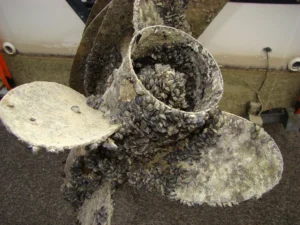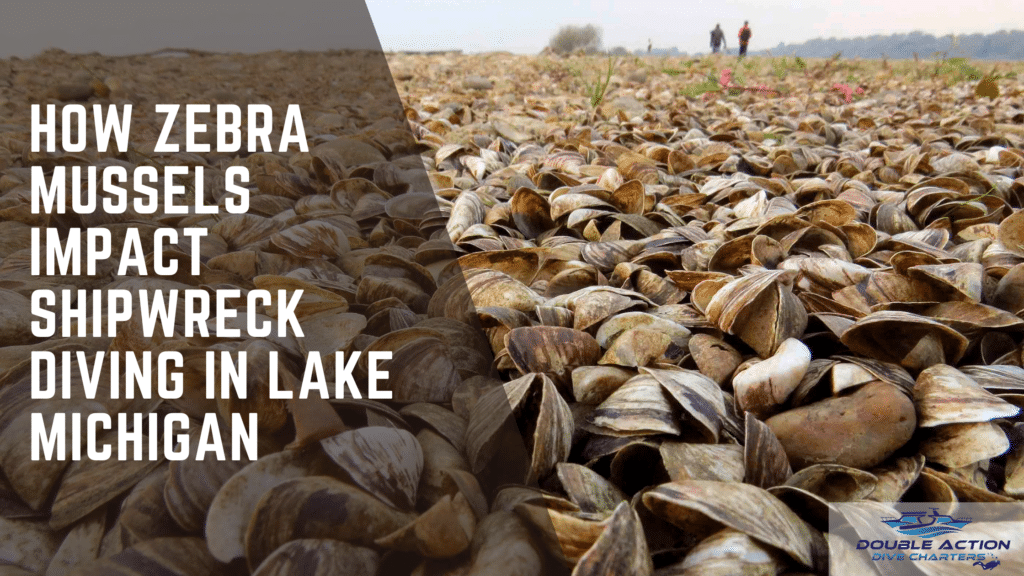Lake Michigan, with its rich maritime history, has undergone a dramatic transformation, all thanks to one tiny powerhouse: the zebra mussel. This little filter feeder from Russia isn’t just about muscling up; it’s clearing up our dives!
Explore the pristine underwater environments with Double Action Dive Charters, the premier experts in Lake Michigan shipwreck tours. Discover more and book your next diving adventure with Double Action Dive Charters.
The Zebra Mussel Effect
Zebra mussels, originating from Russia, have dramatically improved the ecological dynamics of Lake Michigan by filtering out algae that cloud the water. Their ability to clean and clear the waters has notably increased underwater visibility, often up to 100 feet, allowing for more detailed exploration of the lake’s historic shipwrecks.
While it’s true that zebra mussels have filtered the water and made it clearer for dive enthusiasts to enjoy, their arrival has also led to some significant issues in the Great Lakes ecosystem.
As these invasive mollusks spread, they cover the lakebed and other underwater surfaces (like the bottoms of boats) with dense colonies, causing problems for native species and disrupting the natural balance of the ecosystem.

Here’s a breakdown of why zebra mussels are causing such a stir:
- Native Species Under Pressure: Zebra mussels are competing with native filter feeders for food, space, and resources, which is leading to declines in populations of native mussels and other aquatic organisms.
- Infrastructure Woes: Those mussel colonies are accumulating on pipes, water intake structures, and machinery, causing blockages and impairing the functioning of industrial and municipal water systems.
- Upsetting the Food Chain: With the proliferation of zebra mussels, the availability of food resources in the Great Lakes is being altered, which is impacting the entire food web from plankton to fish, with potential cascading effects on ecosystem health.
- Sticking Where They’re Not Wanted: Zebra mussels are attaching themselves to boat hulls, docks, and other submerged structures, increasing maintenance costs and facilitating the spread of invasive species to new areas.
- Economic Strain: The economic impacts of zebra mussels extend beyond direct infrastructure damage, including losses to commercial and recreational fishing industries, reduced property values due to impaired water quality, and increased costs for water treatment and invasive species management.
How Did Zebra Mussels Get to the Great Lakes?
First, we need to travel back to 1959, when the U.S. and Canadian governments made a monumental change to Lake Michigan’s ecosystem. They constructed the St. Lawrence Seaway, a network of channels, locks, and dams, allowing ocean freighters to navigate from the untamed St. Lawrence River right into the heart of the continent. Little did they know, this action inadvertently removed a natural barrier, making it easier for invasive species like zebra mussels to find their way into the lake.
The invasion of zebra mussels into the Great Lakes is believed to have started in the late 1980s. They were first discovered accidentally by a marine biologist searching for muck-loving worm. To her surprise, Sonya Santavy discovered tiny rocks resembling pebbles, and quickly noticed one of those pebbles was alive. Yikes.
Originally hailing from the Caspian and Black Seas in Eurasia, these tiny troublemakers likely caught a ride in the ballast tanks of ships that emptied their water into the Great Lakes upon arrival.

Then in 1988, zebra mussels turned up in Lake St. Clair, some 3,000 miles from its closest known colony.
Once they settled in, zebra mussels wasted no time spreading throughout the Great Lakes, thanks to their rapid reproduction rate and lack of natural predators in the ecosystem. Their arrival has had significant repercussions, both ecologically and economically, on the Great Lakes region.
Today, these mollusks have spread like a relentless, gnarly blanket across the bottom of Lake Michigan, forming dense clusters exceeding 35,000 per square meter—a sight that’s both fascinating and alarming.
What to Do If You Encounter Zebra Mussels on Your Dive
While we certainly prioritize safe and fun dives here at Double Action Dive Charters, as you read above, it’s impossible to totally avoid invasive species while diving in the Great Lakes. If scuba divers encounter zebra mussels during their dive, it’s essential to take appropriate precautions to avoid unintentionally spreading them further.
Here’s what divers should do:
- Avoid Contact: Refrain from touching or disturbing zebra mussels to prevent their spread to new areas. We know that’s like putting a giant “do not push” sign on a red button, but please, do your best to avoid touching the mussels.
- Report Sightings: If possible, note the location of the zebra mussel sighting and report it to local authorities or organizations involved in invasive species management. Providing information about the sighting can help track the spread of zebra mussels and inform management efforts.If you’re on one of our charters, be sure to tell your captain and we’ll report it.
- Clean Gear: After the dive, thoroughly clean and inspect all dive gear, including wetsuits, fins, masks, and regulators, to remove any potential zebra mussel larvae or adults. Pay close attention to crevices and hard-to-reach areas where mussels may hide.
- Dry Gear: Allow dive gear to dry completely before using it in another water body. Zebra mussels can survive out of water for several days, so drying gear helps ensure that any attached mussels or larvae are killed. This prevents you from being the zebra mussel delivery man bringing the invasive little creatures to all of your favorite (and our favorite) dive spots.
- Follow Local Regulations: Be aware of and adhere to any regulations or guidelines in place regarding the prevention and management of invasive species in the area where you are diving.
A New Era for Shipwreck Diving
As Lake Michigan’s waters have become clearer due to the presence of zebra mussels, a new era has dawned for shipwreck diving in the region. This enhanced clarity has transformed Lake Michigan into a premier destination for divers from around the globe. Beyond the aesthetic appeal of crystal-clear waters, the improved visibility offers substantial benefits for scuba divers, enhancing their overall diving experience in several ways.
- Detailed Shipwreck Exploration: The increased visibility afforded by clearer waters allows divers to delve deeper into the history and intricacies of shipwrecks resting on the lakebed. With greater clarity, divers can observe and document the fine details of these submerged relics, uncovering insights into their construction, historical significance, and the events that led to their demise.
- Navigation and Orientation: Clearer water provides better orientation for divers navigating through shipwrecks and underwater structures. Improved visibility enables divers to more easily locate entry points, explore interior spaces, and navigate safely through the wreckage, enhancing overall safety and confidence during dives.
- Photography and Videography: Crisp, clear water conditions are a boon for underwater photographers and videographers, allowing them to capture stunning images and footage of shipwrecks and marine life with greater clarity and detail. The enhanced visibility facilitates the creation of visually compelling media that showcases the beauty and allure of Lake Michigan’s underwater landscapes.
- Environmental Awareness: Clearer water conditions promote greater environmental awareness among divers by providing a clearer view of the underwater ecosystem. Divers can observe and appreciate the diverse marine life and habitat surrounding shipwrecks, fostering a deeper appreciation for the importance of conservation and preservation efforts in the Great Lakes region.
- Educational Opportunities: The improved visibility in Lake Michigan offers enhanced educational opportunities for divers interested in maritime history, archaeology, and underwater exploration. Clearer water conditions facilitate research and documentation efforts, allowing divers to contribute valuable data and insights to ongoing studies of shipwrecks and underwater heritage sites.
The enhanced clarity courtesy of zebra mussels in Lake Michigan has truly taken shipwreck diving to the next level! Divers now have the chance to embark on thrilling underwater adventures filled with exploration, discovery, and a deep appreciation for the fascinating maritime history and underwater wonders of the region. It’s like diving into a living museum, where every wreck tells a captivating story waiting to be uncovered. So grab your gear and get ready for an unforgettable dive experience unlike any other!
Explore the Effects of Zebra Mussels with Double Action Dive Charters
Double Action Dive Charters offers expertly guided tours to some of the most intriguing shipwrecks in Lake Michigan, all shiny and clean thanks to zebra mussels. Our experienced crew ensures a safe and insightful experience for divers of all levels. Here are some iconic shipwrecks you can explore with us:
The Thomas Hume: Mysteriously vanished in 1891 and rediscovered in 2006, this well-preserved schooner offers a vivid window into 19th-century maritime commerce, now beautifully visible in the clear waters. Thanks to the clarity brought by zebra mussels, the well-preserved schooner is now even more striking in the clear waters, with intricate details and historical artifacts beautifully visible to divers exploring its depths.
Material Service: Sunk during a storm in 1936, this large gravel barge rests upright in relatively shallow waters, making it an excellent site for both beginner and experienced divers. While zebra mussels may cover some surfaces of the Material Service, obstructing some views, they also enhance visibility, allowing divers to appreciate the barge’s impressive size and structure as they explore its underwater realm.
Straits of Mackinac: Intentionally sunk in 2003 to create an artificial reef, this 204-foot former car ferry features multiple exploration layers, each teeming with aquatic life, an ideal spot for eco-divers.
The Buccaneer: Intentionally sunk in 2010 to serve as a dive site, this vessel offers a contemporary dive experience with well-preserved features ideal for advanced divers. Despite the presence of zebra mussels, the ship’s transformation into an artificial reef has contributed to the flourishing of local marine ecosystems, making it a vital asset in the preservation of underwater habitats in the Great Lakes.
Join Us for a Dive
With the clearer waters provided by zebra mussels, diving in Lake Michigan is more accessible and enjoyable than ever. Whether you are a history enthusiast, an environmental advocate, or a diving novice, the shipwrecks of Lake Michigan offer unparalleled adventures.
Book your dive today with Double Action Dive Charters and experience the crystal-clear waters and amazing shipwrecks of Lake Michigan. Visit our scheduling page to secure your spot on one of our unforgettable tours. Dive into history and beauty in the pristine waters of Lake Michigan!

